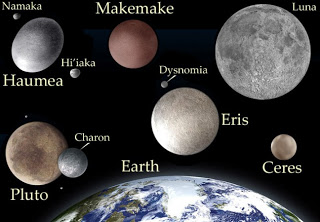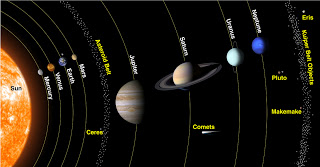Astronomy

Dwarf planets are worlds that are too small to be considered full-fledged planets, but too large to fall into smaller categories.In recent years, there's been a lot of hubbub about Pluto losing its status as one of the planets in our solar system. Pluto is no longer considered the ninth planet in the series of major planetary objects, but instead is now just one of the many so-called "dwarf planets." Astronomers estimate that there could be as many as 200 dwarf planets in the solar system and Kuiper Belt.
The International Astronomical Union defines a planet as being in orbit around the sun, has enough gravity to pull its mass into a rounded shape (hydrostatic equilibrium), and has cleared its orbit of other, smaller objects. This last criterion is the point at which planets and dwarf planets differ. A planet's gravity either attracts or pushes away the smaller bodies that would otherwise intersect its orbit; the gravity of a dwarf planet is not sufficient to make this happen
Pluto, Eris, Haumea, and Makemake are all known as "plutoids," unlike the asteroidal dwarf planetoid Ceres. A plutoid is a dwarf planet with an orbit outside that of Neptune. Plutoids are sometimes also referred to as "ice dwarfs" due to their diminutive size and cold surface temperatures.
The outer planets show evidence of interaction with plutoids. The largest moon of Neptune is likely a captured plutoid, and it is even possible that the odd tilt of Uranus on its axis is due to a collision with a plutoid. Similarly to dwarf planets, there are potentially hundreds of plutoid objects in the solar system that have yet to be given official status.

Facts :
In 2006 the International Astronomical Union adopted the term ?dwarf planet? for solar system objects that were bigger than small solar system bodies such as comets and asteroids but not quite planets.
All the dwarf planets are found in the Kuiper Belt with the exception of Ceres which is found in the asteroid belt.
No dwarf planets have yet been visited by space probes though in 2015 NASA?s Dawn and New Horizons missions will reach Ceres and Pluto respectively.
- Sky Watching Dec 18 - 25
Sky Watching 2012,December,18-25 Tue., December 18, 4 a.m. Ceres at opposition...
- Picture Of The Day - Nov 5
Picture Of The Day 2012 November , 5 ...
- Do You Know - 3
Do You Know? - 3 1 . What is the name of the 2nd biggest planet in our solar system? Ans: Saturn ...
- Picture Of The Day Oct - 25
Picture Of The Day October 25 , Thursday The Cone Nebula (NGC 2264) ...
- Astronomy Quiz
Do You Know? 1. What is the brightest star in the night sky at any time? ...
Astronomy
Dwarf Planets
Dwarf Planets

The International Astronomical Union defines a planet as being in orbit around the sun, has enough gravity to pull its mass into a rounded shape (hydrostatic equilibrium), and has cleared its orbit of other, smaller objects. This last criterion is the point at which planets and dwarf planets differ. A planet's gravity either attracts or pushes away the smaller bodies that would otherwise intersect its orbit; the gravity of a dwarf planet is not sufficient to make this happen
Pluto, Eris, Haumea, and Makemake are all known as "plutoids," unlike the asteroidal dwarf planetoid Ceres. A plutoid is a dwarf planet with an orbit outside that of Neptune. Plutoids are sometimes also referred to as "ice dwarfs" due to their diminutive size and cold surface temperatures.
The outer planets show evidence of interaction with plutoids. The largest moon of Neptune is likely a captured plutoid, and it is even possible that the odd tilt of Uranus on its axis is due to a collision with a plutoid. Similarly to dwarf planets, there are potentially hundreds of plutoid objects in the solar system that have yet to be given official status.

Facts :
In 2006 the International Astronomical Union adopted the term ?dwarf planet? for solar system objects that were bigger than small solar system bodies such as comets and asteroids but not quite planets.
All the dwarf planets are found in the Kuiper Belt with the exception of Ceres which is found in the asteroid belt.
No dwarf planets have yet been visited by space probes though in 2015 NASA?s Dawn and New Horizons missions will reach Ceres and Pluto respectively.
- Sky Watching Dec 18 - 25
Sky Watching 2012,December,18-25 Tue., December 18, 4 a.m. Ceres at opposition...
- Picture Of The Day - Nov 5
Picture Of The Day 2012 November , 5 ...
- Do You Know - 3
Do You Know? - 3 1 . What is the name of the 2nd biggest planet in our solar system? Ans: Saturn ...
- Picture Of The Day Oct - 25
Picture Of The Day October 25 , Thursday The Cone Nebula (NGC 2264) ...
- Astronomy Quiz
Do You Know? 1. What is the brightest star in the night sky at any time? ...
